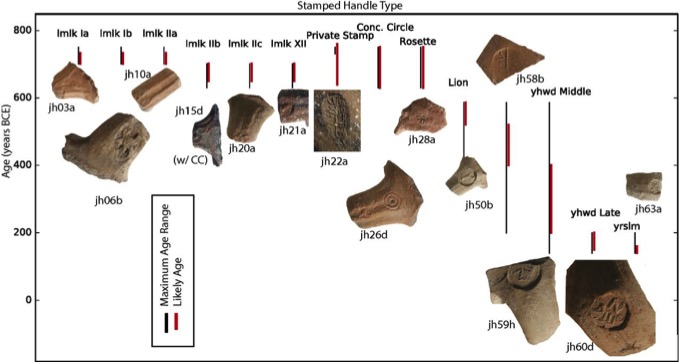
|
MAGNETIC FIELD VARIATIONS RECORDED IN ANCIENT JARS (FIRED CLAYS) A very interesting study on the variations of the intensity of the magnetic field has been conducted using storage jars made of fired clay in the area around Jerusalem (Israel) between the 8th and 2nd century BCE. A quick summary is available from the New York Times, while the article itself (a little bit more of an advanced reading for a non-scientist) is available from the National Academy of Sciences.
 Six centuries of royal Judean stamped handles: basic typology of the seal impressions and their ages from: Erez Ben-Yosef et al. PNAS doi:10.1073/pnas.1615797114 (article linked above) The study is particularly fascinating because we can only observe the variations of the magnetic field if we can track them over time. If you have a single, isolated value of magnetic intensity, its meaning is reduced. This study instead is able to link the values of the magnetic field to objects whose age is known. The magnetic field intensity can be “recorded” in rocks (such as the basalts of the oceanic crust) and within a few artifacts, such as the fired clays of this study. These fired jars from Jerusalem were chosen because they both preserved a record of the magnetic field (which was locked in the clays at the time of their firing) and they can be dated with a very good level of precision. While the jars cannot be dated per se, they bore the administrative markings of taxes and fees of the ancient kingdom of Judah. These markings were changed in time rather regularly, and they follow a sequence that is very well known, comparable for instance to the alphanumeric sequences in cars’ license plates. Using sequences of objects or fossils that change in time and whose age is known or can be well constrained is what geologists and paleontologists do in order to establish a relative sequence of events: William Smith’s principle of fossil succession relies on the same concept: that change occurs over time, and as a consequence change defines and constrains a specific time interval. When Smith laid out his idea, the actual numerical age of rocks and fossil was not known, but the beauty of this concept is that it nonetheless works in establishing a known sequence of events.
© Alessandro Grippo, since 1994 last updated: March 29, 2018 Go back to the MAIN page Go back to the ARTICLES and BLOGS page |